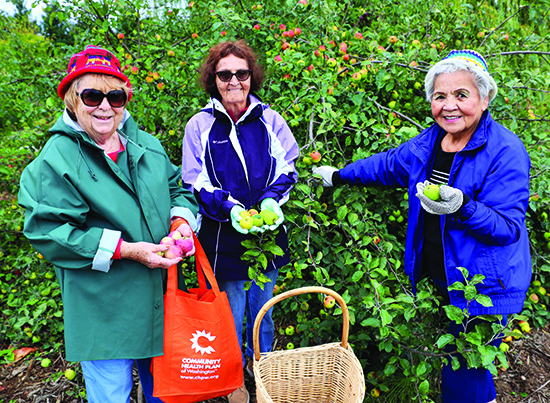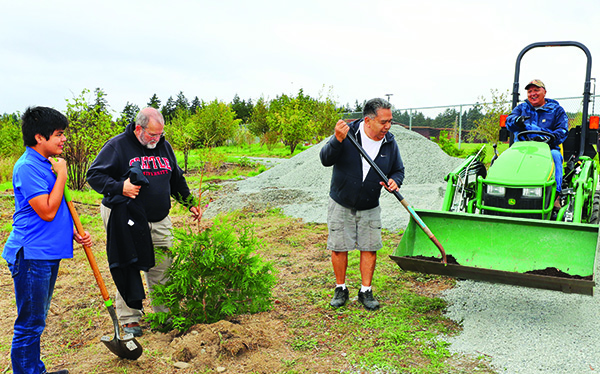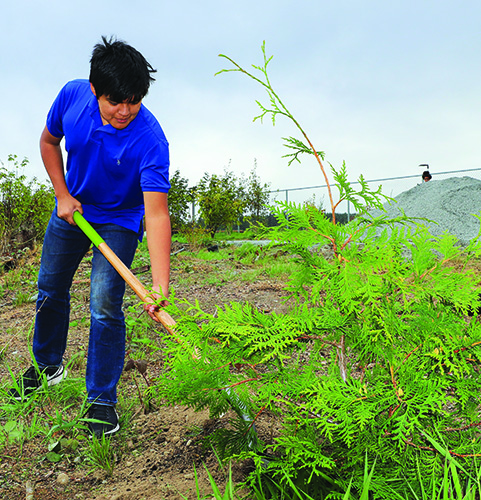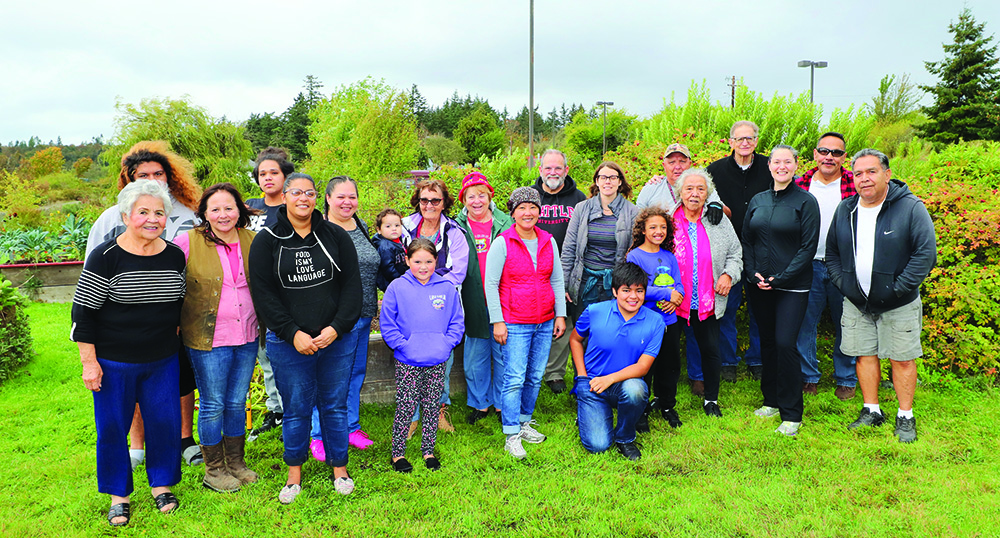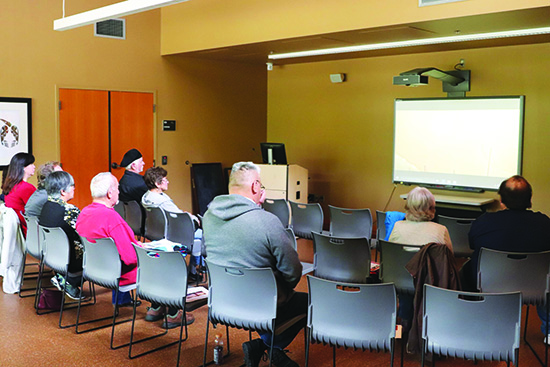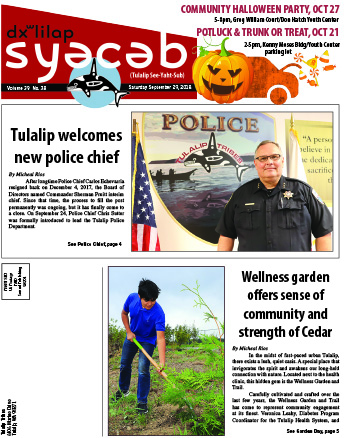Native Homeownership, The Guide to Buying a Home
Wellness garden offers sense of community and strength of Cedar

By Micheal Rios, Tulalip News
In the midst of fast-paced urban Tulalip, there exists a lush, quiet oasis. A special place that invigorates the spirit and awakens our long-held connection with nature. Located next to the health clinic, this hidden gem is the Wellness Garden and Trail.
Carefully cultivated and crafted over the last few years, the Wellness Garden and Trail has come to represent community engagement at its finest. Veronica Leahy, Diabetes Program Coordinator for the Tulalip Health System, and her dedicated team of health-conscious staff members have been instrumental in fostering the sense of community a wellness garden can offer.
“Our goal has always been to make everyone feel welcomed, needed and valued,” reflected Veronica on the success of garden day classes routinely hosted at the Wellness Garden. “Our diabetes prevention team is greatly appreciated; everyone gives their all for our events. I feel humbled to be a part of the effort to teach people about healthy foods and increased activity in ways the community connects with. This is the essence of a proactive, holistic approach to diabetes care and prevention.”
A community of expert and novice gardeners made up of tribal members of all ages routinely attends the monthly garden day classes. Over the past planting season, the group tended the soil and grew vegetables (kale, squash, zucchini, cabbage), edible flowers (sunflowers, lavender, nettles), an assortment of seasoning herbs, and berries galore. Raspberries, strawberries, elderberries, and salmonberries, just to name a few, have all taken to the Wellness Garden’s planting beds and have shared their sweet nectar via healthy snacks and meals.
During summer’s final Saturday, the community gardeners came together for this season’s last garden day walk and gathering. There were nearly 30 community members altogether, varying in age and expertise, who enjoyed getting their hands dirty by weeding and pruning the garden, before harvesting apples and pears aplenty. A memorable experienced was shared when the group planted several baby Cedar trees.
“It’s been such a lovely day,” shared honorary tribal member, Father Pat Twohy. “Everybody came together with good spirits to work in the garden. There was so much happiness shared while we picked apples, pulled weeds, and especially when we planted Cedars. To top it off, the cooks provided us with a lovely breakfast and magnificent lunch. Altogether, it was a happy day and I’m so grateful for everyone who made this possible.”
Gardening is a great way to incorporate the power of ancient wisdom and traditions while cultivating food to bring about growth and healing. There is tranquility in the sounds of nature, the smell of fresh earth, and the warmth from the sun. Most gardeners agree that they feel a sense of calm wash over them as they work with the plants and flowers. Some even are reminded of a time not too long ago, before cell phones and the internet ruled the day.
“It warms the heart to see so many happy people in one place,” beamed Tulalip elder Virginia Carpenter. “I just love gardening, and it’s so great to see the younger generation come out and be a part of this. Seeing families, parents with their kids, out here having a good time it reminds me of the olden days; when kids used to go with their parents everywhere and people were happy to be out of the house.”
Of the 30 community member who attended the September 22 garden day, several were first-time tribal member participants. They jumped right in to the garden activities and assisted their elders whenever possible.
The youngest and longest attending tribal member, 15-year-old Kaiser Moses who has been attending gardening classes since he was just 4-years-old, was seen teaching others how to plant a variety of crops and how to best harvest the ready fruits. Kaiser reiterated our connection with nature by sharing, “the plants and trees are alive, and it’s up to us to take care of them and keep them healthy.”
“I stood back and listened to Kaiser’s words and teaching and my heart was so full, it was hard to hold the tears back,” added Veronica. “I watched our elders work with the new tribal members and saw real joy in their faces; this is my motivation for the garden days. Every bit of effort and time is worth it to see and feel the community effort shared by all. It has always been and continues to be a very special time for whoever comes and joins us.”
Following several mindful hours in the Wellness Garden, the group organized indoors for a delicious meal cooked by culinary chef, Britt Reed. There were pumpkins and pumpkin carving kits given to everyone, along with a variety of raffle prizes that included gardening supplies and cooking utensils.
This upcoming winter, an all-new greenhouse project will be opening to the community which will allow the gardening activities to continue inside and more classes to be taught around food preservation. Be on the lookout for future flyers detailing this project on Tulalip News and Tulalip News Facebook page.
Hibulb Film Festival celebrates music, language and culture
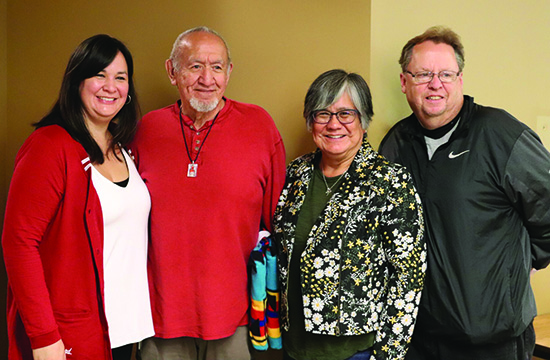
By Kalvin Valdillez, Tulalip News
The art of storytelling has been passed down generation after generation since time immemorial. In Native America, stories are shared to teach youth valuable lessons while incorporating traditional songs, dances and language. Sacred animals such as killer whales, eagles, wolves, bears and ravens often play a role in many traditional stories as well as legendary creatures like Slapoo, Sasquatch and Thunderbird. Indigenous stories explain the mysteries of the universe like how the sun, stars and moon came to be and also emphasizes cultural values like respecting your elders, helping your community and practicing your ancestral teachings.
As technology advanced, storytellers began to explore new forms of storytelling through art, poetry, music, film and animation. Classic stories have been given new life through film and new ideas are created to raise awareness about current issues in the Native American community like climate change, declining fish runs, missing Indigenous women, suicide and overdose. Native musicians often use their storytelling abilities to construct powerful songs that promote positive messages about protecting our waters, healing from generational trauma, decolonization and of course, finding love.
In today’s fast-paced social media society, the most popular form of storytelling is multimedia. Thousands of creative Native minds upload visuals to platforms like Facebook, YouTube, Snapchat and Instagram every day, whether they’re showcasing their comedic skits, music videos, news or short films, the artists are using their voice, video footage and photos to perfect the art of storytelling.
On the first day of fall, September 22, the Hibulb Cultural Center hosted their annual film festival, celebrating the new wave of storytelling. Local and international filmmakers were invited to share their work with the Tulalip community and nine video entries were selected for this year’s festival, which was centered around music.
“This year is the 6th Annual Film Festival, with a music theme entitled Frog Catches a Song,” says Lena Jones, Film Festival Organizer and Hibulb Cultural Center Education Curator. “The Hibulb Cultural Center Film Festival initially began as a way to celebrate the power of cinema, to tell the stories of our many cultures and to honor and recognize Coast Salish filmmaking and filmmakers. We always hope to introduce or strengthen the filmmaking and artistic talents within our own community. This year, we continued to receive outstanding programming with films that featured traditional and contemporary music, language and culture. The festival had an international flair as well, by films from Tomer Werechson of Israel, Bernard Weilavani (Wolfsheart) of Austria, and Ian McKay-Weaselfat of Canada.”
La Gran Final de Piano, by Tomer Werechson, was a one-minute film about an old, classic piano but the keys played the kicks and snares of an 808 drum kit, much like a modern midi-keyboard. Bernard Weilavani, professionally known as Wolfsheart, is a Native American flutist who submitted two of his music videos, Walking the Wolf Path and Wolfsheart House of the Rising Sun. And First Nations rapper, Ian McKay-Weaselfat, chose to share the music video for his song, Puppy Love.
Tulalip filmmaker, David Spencer Sr., participates in the festival every year and creates his films based upon the theme. Last year, David wowed the crowd with his movie, Waiting for Blackberries and followed this year with I Am Frog, which was performed entirely in Lushootseed. David received the Best Film Award this year for his fifteen-minute presentation which included original songs and photos within his film.
“It’s a story about frog who didn’t have a song,” says David. “She despised all her friends; crow, coyote, bear and owl because she didn’t have a song. All of them offer advice on how to prepare yourself to get a song. Once she realizes they’re trying to help her, she gets her song. The moral of the story is, even though we all may despise somebody or they might despise us, we’re meant to come together and to do this spiritual work and help one each other out.”
Following I Am Frog, the Film Festival featured an important screening, created by Lummi tribal member Freddie Lane, about the southern resident orcas and the Lummi Nation’s effort to return the last remaining poached orca, Tokitae, back to the Salish Sea.
“This year, the judges chose to honor Frederick “Freddie” Lane for Special Recognition for a Lifetime Achievement in Filmmaking and Cultural Sharing,” states Lena. “He has been an important voice in the nation. His film Qwel lhol mech ten (the People that Live under the Water) is exemplary of his commitment to protecting the earth, educating communities about tribal history and standing with leaders to preserve and promote the Coast Salish way of life for all future generations. Qwel lhol mech ten received the Best Documentary Short Award.”
Three local film lovers were selected as judges for this year’s event, Brit Reed (Choctaw), Robin Carneen (Swinomish) and Lois Landgrebe (Tulalip). Robin judged over half of the festivals throughout the years and assisted with this year’s theme and artwork, stating the story Frog Catches a Song came to her in a dream.
“It’s fascinating seeing all this creativity,” expresses Robin. “I used to do a lot of media with the kids here at the Boys and Girls Club. I really wanted to help create more storytellers in the generations that are coming up. I’d definitely like to see more youth films; however, I’m thinking maybe we need to have a youth film festival and really challenge the youth to turn in some films and explore storytelling. In the meantime, we’ve had some really great entries. This year was unique and that’s what I love about film festivals, you don’t know what each film will look like because everyone’s a storyteller but they tell their stories in different ways.”
Robin’s love for multimedia led to a large involvement during the 2018 film festival. This year she spread the word by inviting local filmmakers and musicians to participate from the many forums that she follows on Facebook. The invitations gained a lot of inquiry and three films were submitted resulting from the social media outreach, including the two Wolfsheart music videos and a four-minute film called Thought Dream by Edmonds songwriter and filmmaker, Ed Hartman.
“They found me on Facebook,” said Ed. “I’m a composer and I make videos mostly to promote my music. I post my videos on different filmmaker pages and groups because I’m trying to score movies in the future. They invited me to submit to this festival so I went ahead and did it. It’s a wonderful, intimate festival. The film was this serendipitous moment. We live in Edmonds and go down to the beach quite a bit. There was a guy who was releasing giant bubbles and all I had was my phone with me, so I started to shoot some video. There was smog out at that time, it was late in the evening so the sun was on the low horizon.
“When I got back in my studio I looked through my music to see what matched the footage,” he continues. “I found an interesting track that matched called Thought Dreams. Very much like the theme of this festival, Frog Catches a Song, everything about this project has been just that; catching the bubbles, the bubbles catching the sun, the festival catching me, the video catching the song. Everything’s coming full circle and I’m just thankful for the invitation, this absolutely inspires me to work more on the filmmaking side.”
The attendees were intrigued by a film about Hispanic American artist, Roberto Chavez, who is famous for his murals in Los Angeles during the seventies. The film, The Execution Painting, was a time-lapse of the artist painting a bar scene which featured many people of different ethnicities enjoying a good time. While he created his mural he spoke about his art being destroyed on walls throughout the city, before painting over his own mural with white paint, seconds after it’s completion.
The afternoon ended with an informational film put together by the Hibulb Cultural Center. The video explained the history of Tulalip music beginning with traditional songs performed during ceremonies. During the boarding school experience, several Tulalip tribal members picked up instruments such as the trombone by Robert Shelton and the violin by William Shelton. Many Native girls were in choirs and as the video explains, standout vocalist Maria Sneatlum became Tulalip’s first opera singer.
After a year’s worth of hard work, the Hibulb Cultural Center film festival featured many important and intriguing films. The museum will continue hosting their monthly film series with the next screening held on October 18 at 6:00 p.m. about cultural survival and Indigenous child removal.
“We are grateful to this year’s judges,” says Lena. “We also thank film volunteer Mike Van Luvan and Cary Williams who opened the event with his exceptional flute playing. As always, we encourage Tulalip members who are interested in filmmaking and media work, or any artform, to continue following their interests or passion. Filmmaking is a great avenue to share your voice and is a valuable artform to preserve cultural art, language, and ideals. It gives us the means to unite communities and showcase the beauty in our culture and our community.”
To view the films featured at the 6th Annual Hibulb Cultural Center Film Festival as well as the winners, please visit www.HibulbCulturalCenter.org
Tulalip welcomes new police chief
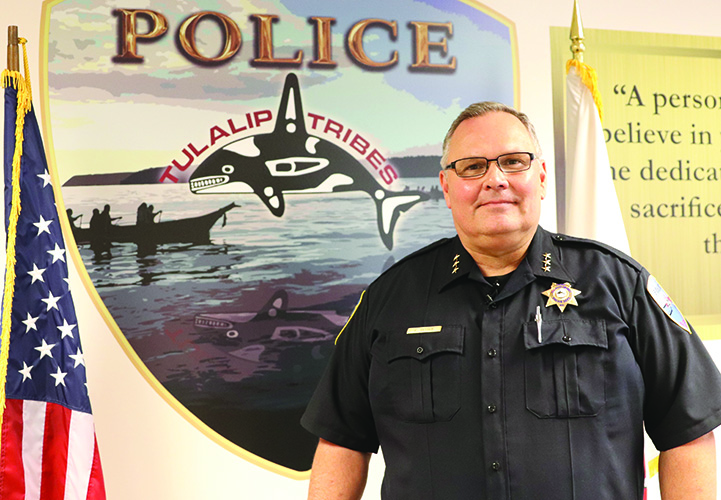
By Micheal Rios, Tulalip News
After longtime Police Chief Carlos Echevarria resigned back on December 4, 2017, the Board of Directors named Commander Sherman Pruitt interim chief. Since that time, the process to fill the post permanently was ongoing, but it has finally come to a close. On September 24, Police Chief Chris Sutter was formally introduced to lead the Tulalip Police Department.
“The Tulalip Tribes is pleased to announce that Chris Sutter is joining the Tulalip Police Department as our new Chief of Police. Following a comprehensive search for the right candidate, Chief Sutter’s experience and background quickly rose to the top of our candidate pool. We welcome Chief Sutter and his family to our community,” stated Chairwoman Marie Zackuse.
Chief Sutter met with syəcəb staff for an interview detailing his past experience as a law enforcement officer and what his immediate vision is for leading the tribal police department. What follows is an unedited transcript of that interview.
Q: The first thing many are wondering is what is your law enforcement background?
A: I come to Tulalip with 32-years of law enforcement experience. The last 26 years has been with the City of Vancouver in southwest Washington, where I served as assistant chief of police the past 10 years.
Q: Please describe your experience working with Native communities?
A: My experience working with Native communities is more on the personal family side. I’m married to an enrolled tribal member of the Navajo nation. For 38-years, we’ve enjoyed a very happy family and close relations with our tribal family. Also, in my previous role as assistant chief, I held a monthly diversity advisory meeting with representatives of the diverse Vancouver community which included Native American representation.
Q: Uprooting from Vancouver, will you be living in Tulalip now?
A: Yes, I found a rental home here in the community and am very much looking forward to being part of the community. As the school year completes, my wife and daughter will joining me here in Tulalip.
Q: What are some of the goals you’d like to achieve over the next couple years with the Tulalip Police Department?
A: I have many goals and a high-level vision for moving the department forward. Number one is to make sure Tulalip is a safe and secure place for families, children and the elders. We’re going to start by eradicating the drug problem in the neighborhoods. We’ll also be working on community outreach to make sure people know that their police department is here to serve them. In addition, we’ll be looking into ways we can best serve the fish and wildlife branch of the department to ensure tribal sovereignty and treaty rights are always respected and upheld.
Q: Our last few police chiefs have tried to tackle the opioid epidemic. What are some ideas you bring to the table on this issue?
A: Number one is we can’t allow people to be selling drugs to our tribal members and anyone else in the community. We have to crack down on those who are profiting on this horrible trade that causes such devastating impacts to individuals and families. We’ll be implementing a very robust narcotics taskforce that’s going to take down the dealers. In my opinion, the first step is to go after those people who are bringing the drugs into our community.
Q: How do you see the Tulalip Police Department engaging with the community going forward?
A: Community engagement is as simple as directing all the officers to make sure they are taking the time to get out of their cars in order to walk and talk with people we serve. Making face-to-face, personal connections is the first step to building a better relationship. We are also going to find opportunities to sit with tribal elders and receive their guidance and wisdom, ensuring we have good open lines of communication. Additional outreach will involve our youth. I strongly believe the youth are our future and the more we outreach, mentor, and guide them to make good life choices the better the outcomes.
Q: Describe your experience working with tribal police?
A: During my time in Vancouver, I acquired experience working with the Cowlitz Reservation and their newly created police department under former Tulalip police chief Goss. Through that connection we built a quality working relationship and provided assistance to each other when needed.
Q: What’s your message to the Tulalip community?
A: I feel blessed to be here to serve the people. My message is we are here to serve you. We want to make sure you always feel welcome and comfortable to make contact with our dedicated staff of officers and civilians. My commitment to the community is we are going to do our very best to make your neighborhoods secure and to make Tulalip Reservation a place residents are very proud to live.
Tulalip Bay Affordable Work Force Rental
This Rental Home Features: 1 Bedroom, 1 Bath, a Wood Burning Fireplace, View of Tulalip Bay, Large Deck, 675 Sq. Ft., Built 1955.
Tenant will be selected through a lottery selection on October 31, 2018 at Noon at the admin. Applications must be turned in to the Asset & Real Estate Department by October 26, 2018 by 3:00pm. A security deposit of $850.00 and first months rent of $850.00 are due before move in, by cashiers check or money order made payable to the Tulalip Tribes. Applicant cannot be delinquent on any debt to the Tribe. Must provide income verification to qualify. Must complete and pass background check and UA screening. All are welcome to attend the drawing.
There will be an Open House on Wednesday October 3rd, 2018 from 11:30 a.m. – 1:00 p.m.
September 29, 2018 syəcəb
Please use the following link to download the September 29, 2018 issue of the syəcəb:
https://www.dropbox.com/s/ee6f3hu0ns9ew7h/September%2029%202018%20sy%C9%99c%C9%99b.pdf?dl=0
The Moms Group Meets Every Tuesday
Tulalip Firearms Facts
September 22, 2018 syəcəb
Please use the following link to download the September 22, 2018 issue of the syəcəb:
https://www.dropbox.com/s/vsl3l00m9ss2p3v/September%2022%202018%20sy%C9%99c%C9%99b.pdf?dl=0


